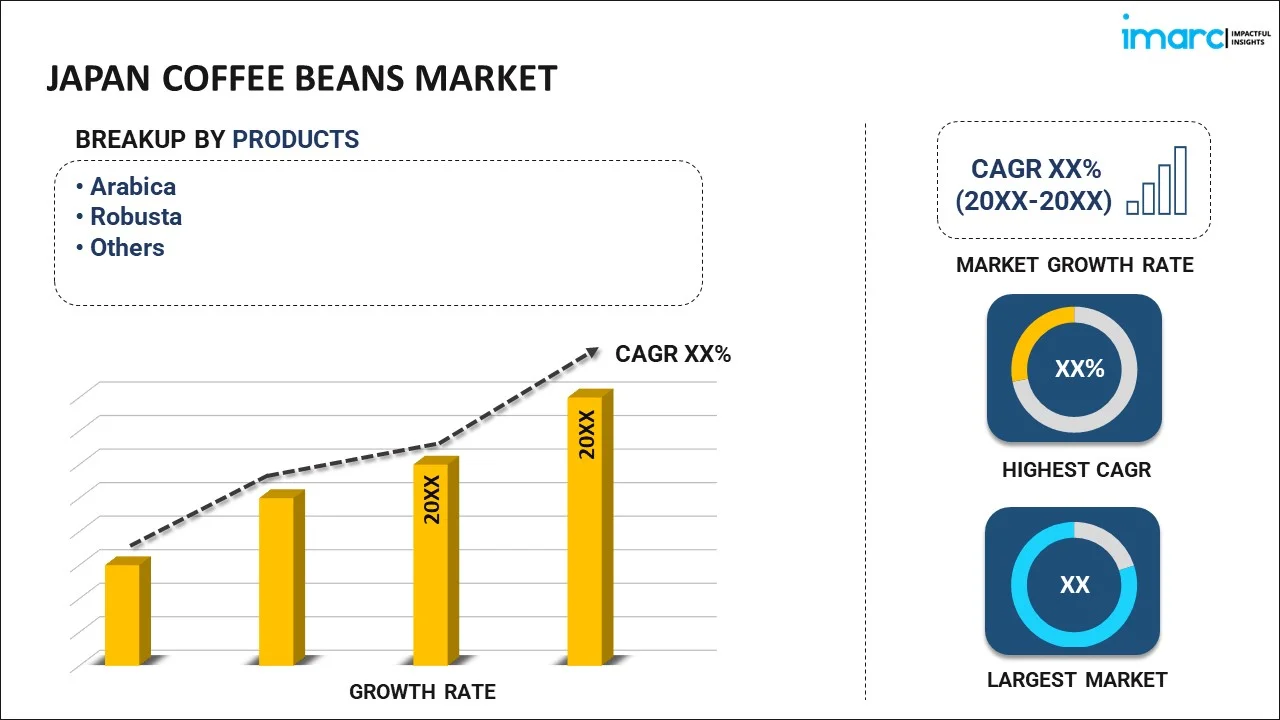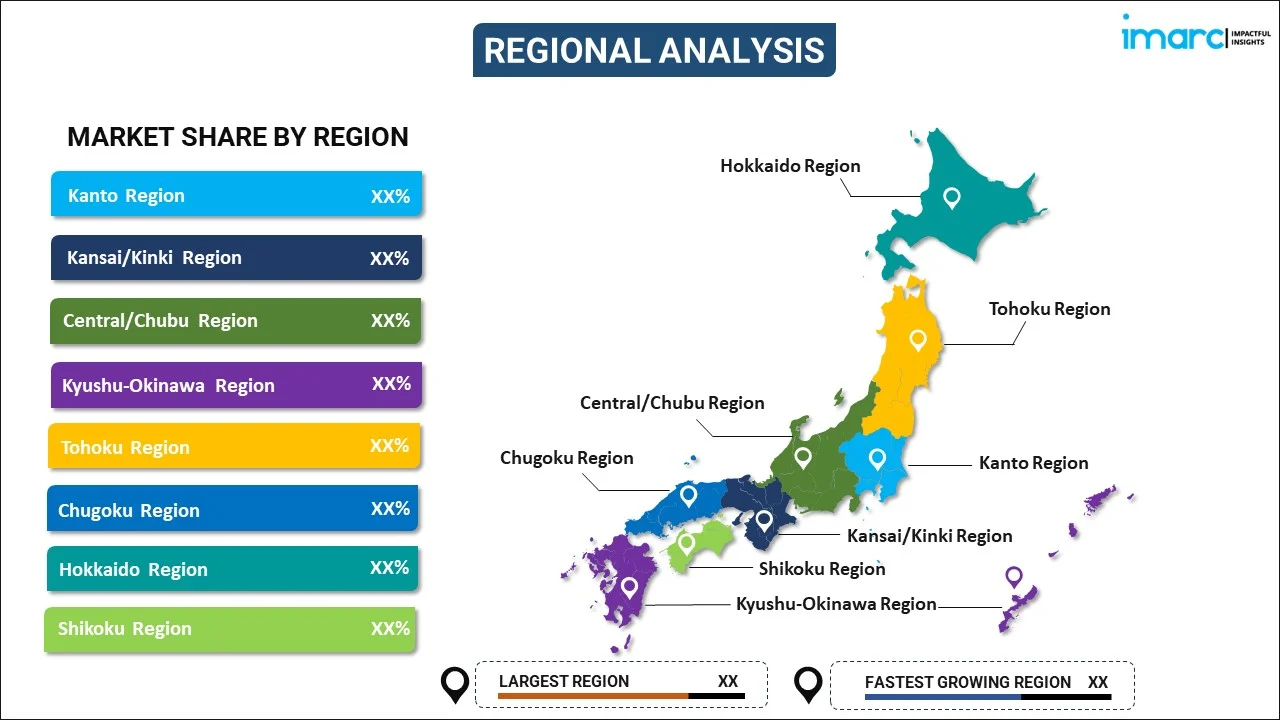
Japan Coffee Beans Market Report by Product (Arabica, Robusta, and Others), Distribution Channel (Online, Offline), End User (Personal Care, Food and Beverages, Pharmaceutical), and Region 2025-2033
Market Overview:
Japan coffee beans market size reached USD 2.0 Billion in 2024. Looking forward, IMARC Group expects the market to reach USD 3.4 Billion by 2033, exhibiting a growth rate (CAGR) of 5.73% during 2025-2033. The increasing advances in coffee processing and farming techniques that can increase efficiency, improve quality, and influence the supply of beans, are primarily driving the market.
|
Report Attribute
|
Key Statistics
|
|---|---|
|
Base Year
|
2024 |
|
Forecast Years
|
2025-2033 |
|
Historical Years
|
2019-2024
|
| Market Size in 2024 | USD 2.0 Billion |
| Market Forecast in 2033 | USD 3.4 Billion |
| Market Growth Rate (2025-2033) | 5.73% |
Coffee beans are the seeds of the Coffea plant, which are harvested and processed to create the beloved beverage known as coffee. These beans are typically found inside the fruit of the coffee plant, often referred to as coffee cherries. The beans are green when freshly harvested and undergo a series of steps to transform into the aromatic brown beans used for brewing. The process starts with drying the cherries, after which they are hulled to remove the outer layers, revealing the green coffee beans. These green beans are then roasted, a crucial step that gives coffee its characteristic flavor, aroma, and color. Roasting involves heating the beans to high temperatures, causing chemical changes that release the familiar coffee scent and taste. The length and temperature of the roast impact the final flavor profile, ranging from light to dark roasts. Once roasted, the beans can be ground and brewed to produce various types of coffee, from espresso to drip coffee.
Japan Coffee Beans Market Trends:
The coffee beans market in Japan is notably influenced by several key drivers, each playing a vital role in shaping its trajectory. Firstly, the rise in coffee consumption, especially among millennials, has undeniably acted as a catalyst for market growth. Moreover, the increasing penetration of cafe culture in Japan, coupled with the emergence of specialty coffees, has further augmented this demand. Additionally, innovations in coffee brewing methods and machinery have expanded the avenues through which consumers can enjoy their brews, enhancing market potential. Furthermore, growing awareness about the health benefits of coffee, such as its antioxidant properties and role in metabolism enhancement, has nudged more health-conscious individuals to embrace it. In addition to this, the aggressive marketing strategies by major coffee chains and brands have elevated its status from just a beverage to a lifestyle choice. On the other hand, there's the crucial factor of the rising middle class in Japan, along with the propensity to spend on luxury items, including high-quality coffee beans. In conclusion, a blend of cultural, economic, and health-driven factors are steering the coffee beans market's expansion, ensuring that its growth remains robust for the foreseeable future.
Japan Coffee Beans Market Segmentation:
IMARC Group provides an analysis of the key trends in each segment of the market, along with forecasts at the country level for 2025-2033. Our report has categorized the market based on product, distribution channel, and end user.
Product Insights:

- Arabica
- Robusta
- Others
The report has provided a detailed breakup and analysis of the market based on the product. This includes arabica, robusta, and others.
Distribution Channel Insights:
- Online
- Offline
A detailed breakup and analysis of the market based on the distribution channel have also been provided in the report. This includes online and offline.
End User Insights:
- Personal Care
- Food and Beverages
- Pharmaceutical
The report has provided a detailed breakup and analysis of the market based on the end user. This includes personal care, food and beverages, and pharmaceutical.
Regional Insights:

- Kanto Region
- Kansai/Kinki Region
- Central/ Chubu Region
- Kyushu-Okinawa Region
- Tohoku Region
- Chugoku Region
- Hokkaido Region
- Shikoku Region
The report has also provided a comprehensive analysis of all the major regional markets, which include Kanto Region, Kansai/Kinki Region, Central/ Chubu Region, Kyushu-Okinawa Region, Tohoku Region, Chugoku Region, Hokkaido Region, and Shikoku Region.
Competitive Landscape:
The market research report has also provided a comprehensive analysis of the competitive landscape in the market. Competitive analysis such as market structure, key player positioning, top winning strategies, competitive dashboard, and company evaluation quadrant has been covered in the report. Also, detailed profiles of all major companies have been provided.
Japan Coffee Beans Market Report Coverage:
| Report Features | Details |
|---|---|
| Base Year of the Analysis | 2024 |
| Historical Period | 2019-2024 |
| Forecast Period | 2025-2033 |
| Units | Billion USD |
| Scope of the Report | Exploration of Historical Trends and Market Outlook, Industry Catalysts and Challenges, Segment-Wise Historical and Future Market Assessment:
|
| Products Covered | Arabica, Robusta, Others |
| Distribution Channels Covered | Online, Offline |
| End Users Covered | Personal Care, Food and Beverages, Pharmaceutical |
| Regions Covered | Kanto Region, Kansai/Kinki Region, Central/ Chubu Region, Kyushu-Okinawa Region, Tohoku Region, Chugoku Region, Hokkaido Region, Shikoku Region |
| Customization Scope | 10% Free Customization |
| Post-Sale Analyst Support | 10-12 Weeks |
| Delivery Format | PDF and Excel through Email (We can also provide the editable version of the report in PPT/Word format on special request) |
Key Questions Answered in This Report:
- How has the Japan coffee beans market performed so far and how will it perform in the coming years?
- What has been the impact of COVID-19 on the Japan coffee beans market?
- What is the breakup of the Japan coffee beans market on the basis of product?
- What is the breakup of the Japan coffee beans market on the basis of distribution channel?
- What is the breakup of the Japan coffee beans market on the basis of end user?
- What are the various stages in the value chain of the Japan coffee beans market?
- What are the key driving factors and challenges in the Japan coffee beans?
- What is the structure of the Japan coffee beans market and who are the key players?
- What is the degree of competition in the Japan coffee beans market?
Key Benefits for Stakeholders:
- IMARC’s industry report offers a comprehensive quantitative analysis of various market segments, historical and current market trends, market forecasts, and dynamics of the Japan coffee beans market from 2019-2033.
- The research report provides the latest information on the market drivers, challenges, and opportunities in the Japan coffee beans market.
- Porter's five forces analysis assist stakeholders in assessing the impact of new entrants, competitive rivalry, supplier power, buyer power, and the threat of substitution. It helps stakeholders to analyze the level of competition within the Japan coffee beans industry and its attractiveness.
- Competitive landscape allows stakeholders to understand their competitive environment and provides an insight into the current positions of key players in the market.
Need more help?
- Speak to our experienced analysts for insights on the current market scenarios.
- Include additional segments and countries to customize the report as per your requirement.
- Gain an unparalleled competitive advantage in your domain by understanding how to utilize the report and positively impacting your operations and revenue.
- For further assistance, please connect with our analysts.

 Inquire Before Buying
Inquire Before Buying
 Speak to an Analyst
Speak to an Analyst
 Request Brochure
Request Brochure
 Request Customization
Request Customization



.webp)




.webp)












